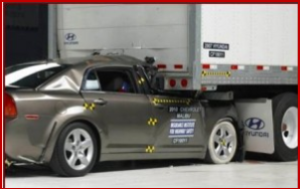 Wabash National Corporation (NYSE: WNC) is making a new rear impact guard design ed to mitigate car under ride optional on its 53-foot dry van trailers. The so-called RIG-16 Guard System is engineered to prevent under ride in multiple offset, or overlap, impact scenarios it’s claimed. The Indiana company has been producing rear impact guards to exceed what the Insurance Institute for Highway Safety says are weak U.S. and Canadian standards since 2007.
Wabash National Corporation (NYSE: WNC) is making a new rear impact guard design ed to mitigate car under ride optional on its 53-foot dry van trailers. The so-called RIG-16 Guard System is engineered to prevent under ride in multiple offset, or overlap, impact scenarios it’s claimed. The Indiana company has been producing rear impact guards to exceed what the Insurance Institute for Highway Safety says are weak U.S. and Canadian standards since 2007.
 Crash tests and analysis by IIHS show that under ride guards on tractor-trailers can fail in relatively low-speed crashes. If they do, the result is often a fatal accident. In 2014, 371 of the 2,485 passenger vehicle occupants killed in large truck crashes died when the fronts of their vehicles struck the rears of trucks.
Crash tests and analysis by IIHS show that under ride guards on tractor-trailers can fail in relatively low-speed crashes. If they do, the result is often a fatal accident. In 2014, 371 of the 2,485 passenger vehicle occupants killed in large truck crashes died when the fronts of their vehicles struck the rears of trucks.

The rear guard on this 2015 Vanguard trailer slowed the Chevrolet Malibu enough to prevent underride in the tough 30% overlap IIHS test at 35 mph.
Gaps in federal crash data make it difficult to pinpoint exactly how many of these crashes involve under ride says IIHS. A 2011 IIHS study of 115 crashes in which a passenger vehicle struck the back of a heavy truck or semitrailer found only about one-fifth involved no under ride or negligible under ride. Nearly half of the vehicles had severe or catastrophic under ride damage, and those vehicles accounted for 23 of the 28 fatal crashes in the study.
When IIHS petitioned the federal government for a stronger under ride guard standard, it asked NHTSA to include test procedures that would address small overlap crashes. IIHS made the request after finding that in cases involving regulation under ride guards, 30% involved crashes in which less than half of the passenger vehicle overlapped the trailer. In most of these, the guards’ vertical supports didn’t engage the passenger vehicle.
NHTSA declined to take up the issue, stating that offset crashes “appear to represent a small portion of the rear under ride fatality problem.”
IIHS believes the agency underestimates the under ride problem. NHTSA uses an estimate of the proportion of fatal crashes that involve severe under ride that was derived from interviews taken long after the crash and thus may not be accurate. What is more, researchers interviewed people who were familiar with the crash but not necessarily driving the truck when it crashed.
“We had hoped for a more a meaningful upgrade to the outdated standard for rear under ride guards,” says Adrian Lund, IIHS president. “As written, this proposal will have a minimal impact on safety. We urge NHTSA not to miss the opportunity to address a wider range of rear under ride crashes.”
Small Overlap Crashes
IIHS crash tests have demonstrated that rear guards can be designed to resist under ride in small overlap crashes. So far, two trailers have successfully stopped under ride in the toughest test, which involves 30 % of the front of a car hitting the trailer at its outermost corner at 35 mph. The test configuration represents the minimum overlap under which the head of a person in a passenger vehicle would contact an intruding trailer if an under ride guard fails.
The revised Wabash rear impact guard is constructed of advanced high-strength steel. Its patent-pending design has two additional vertical posts and a longer, reinforced bumper tube, all of which are engineered to work together to absorb energy better and deflect rear impact at any point along the bumper. In addition, the new guard is fully galvanized to resist corrosion. IIHS will test it this spring.
J.B. Hunt Transport Services, one of the largest transportation logistics companies in North America, recently ordered 4,000 Wabash National trailers with the new rear impact guard. Production of the new J.B. Hunt units began in January.

